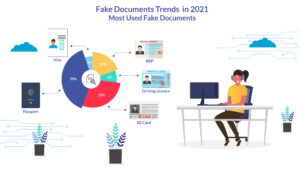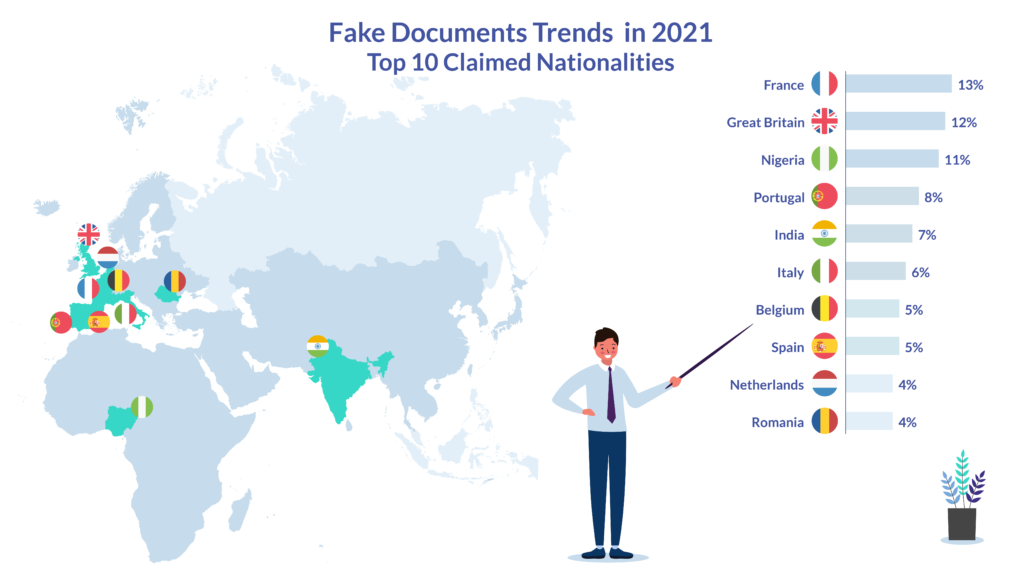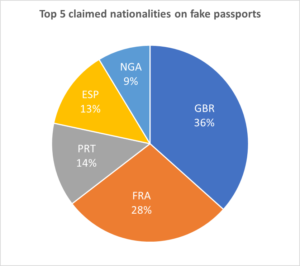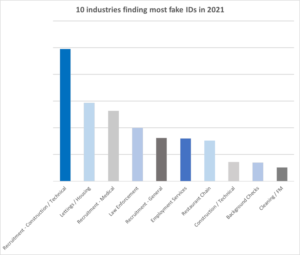Trends in fake identity documents: what happened in 2021?

At TrustID, we constantly monitor and record the number and type of fake identity documents we detect across different industries. This helps us to see what types of documents we need to particularly keep our eye on, which sectors are most at risk, and more.
In this blog, we highlight the trends we spotted throughout 2021. The figures are taken from checks we’ve made for our customers verifying identity documents as part of our Right to Work (RtW), Right to Rent (RtR), and Know Your Customer (KYC) services. Read on to discover what we learnt and for tips on what to look out for when checking ID documents.
What were the most common forms of fake documents in 2021?
As with previous years, passports formed the largest group of fake documents that we found during checks, followed by ID cards. There were some notable changes though: ID cards, which made up 39% of fake documents in 2020, dropped by 10% to 29% in 2021. Conversely, the number of Biometric Resident Permits (BRPs) we identified rose by 8% compared to 2020 to make up 19% of all fake documents in 2021.
Some of these changes may well be linked. For example, since new guidance came into place in June 2021, EU ID cards no longer give eligibility for RtW checks and so holders of fraudulent ID cards may have switched to presenting a fake BRP card instead.

In fact, we predict that as the regulations evolve, so the fraudsters will continue to progress the sort of fraudulent identities they present. In April 2022, for example, the Home Office is due to update RtW and RtR guidance again. From this date, Biometric Residence Permits (BRPs) and Biometric Residence Cards (BRCs) will no longer be acceptable as proof of eligibility for RtW or RtR checks – and applicants will need to present an online share code instead.
HR departments should therefore keep an eye out for an increase in fake BRPs in the run up to the April 2022 deadline, as illegal workers try to use them while they are still acceptable.
What to watch out for
When RtW applicants start using share codes, never accept a printout from your employee as this is not sufficient to prove Right to Work. You must take a share code and date of birth and generate the report yourself. When you’ve downloaded the share code report, make sure the applicant is who they say they are by comparing your applicant to the image on the report. Watch out for cases of ‘imposter fraud’ where the applicant presents a share code which was not issued originally to them.
What was the most common nationality on fake ID documents in 2021?
In 2021, we identified fake ID documents purporting to represent 70 different nationalities – a marked increase of 18 over 2020. France remains the most popular country of origin for fake ID documents, but the UK has leapt from fifth place to second. British documents made up just 4% of fake identity documents in 2019 but this grew to 12% in 2021. It’s also worth noting the growth in Irish documents which made up less than 1% of all fake IDs in 2019 and 2020 and grew to 3% of the total in 2021, making it the 11th most common nationality found.

The popularity of France as an assumed country of origin may relate to the fact that French is commonly spoken in many countries across the world. Portugal and Spain are also high on the list, probably for similar reasons. Brazilians, for example, who live outside the EU, may try to pass themselves off as Portuguese, while Mexicans might assume a Spanish nationality.
The rise in popularity of UK and Irish documents, however, is likely to relate to the fact that EU and EEA citizens no longer have an automatic Right to Work in the UK. Any non-EU/EEA citizens who previously pretended to be from the EU may have switched to claiming a British or Irish identity to get the same rights. In 2021, British was the most cited nationality on fake passports, followed by France.

What to watch out for
As British and Irish passports increasingly become the identity document of choice for fraudsters, familiarise yourself with passport security features to make sure you know how to spot a fake. For more information, read our blog on checking passports. Alternatively, after 6th April, consider adopting a digital Scheme for holders of in-date British / Irish passports which will allow you to make robust, remote digital checks through an IDSP – more information here.
Which sectors were most targeted by identity fraud in 2021?
Recruitment into the construction industry remained at the top of the league table for fake IDs in 2021, as in 2019 and 2020.
The percentage of fake IDs presented to our clients in the housing and lettings sector nearly doubled, from 8% of fake identity documents in 2020 to 15% in 2021. We are uncertain as to whether this was due to an increase in the number of tenants trying to rent properties with fake IDs, or due to organised crime groups trying to rent multiple properties for nefarious purposes.
We also saw a rise in the proportion of fake IDs presented for Right to Work checks in the medical industry, (from 9% to 14%). In such a people-focused industry, it’s especially important to ensure that employees are who they say they are. What’s more, an identity check on an applicant in this sector may well form the basis of additional background or DBS checks so it’s essential to get it right.

What to watch out for
If you’re in a high turnover industry, like construction, healthcare or hospitality, our statistics show that you’re at high risk of being presented with a fake identity document. But no industry is safe and you should always remain vigilant against fraud.
Conclusion
From what we saw in 2021, fraudsters are constantly increasing their understanding of document security features and adapting their production to reflect any legislative changes.
While there may be some benefits to seeing candidates in person, HR personnel and hiring managers are unlikely to be trained identity specialists and that’s what fraudsters are counting on! That’s why we recommend using a certified identity service provider to support your document checks, rather than relying on manual document checking alone.
The increase of fake IDs we saw in the medical sector is particularly worth noting as it’s especially important to make sure that these people are who they say they are.
The other stand-out change in 2021 was the increase in popularity of fake British passports, which have become the gold standard for identity verification in the UK. In fact, our own document verification team has been undertaking a refresher course to guard against the increased risk of fraudulent UK and Irish passports in 2022.
Want to find out more?
If you’re unsure of your ability to spot a fake identity document, why not try our convenient, affordable, and reliable remote checking service? To find out how our services could support you, simply get in touch. We’d be happy to arrange an online demo.
Sign up to receive updates
Receive notifications from TrustID direct to your inbox. Simply fill out your email address in the form below.
Want to find out more?
We’d be really happy to chat through your requirements and offer advice on the best service for your business.
Tel: 0118 466 0822 or email us.
Request a callback


